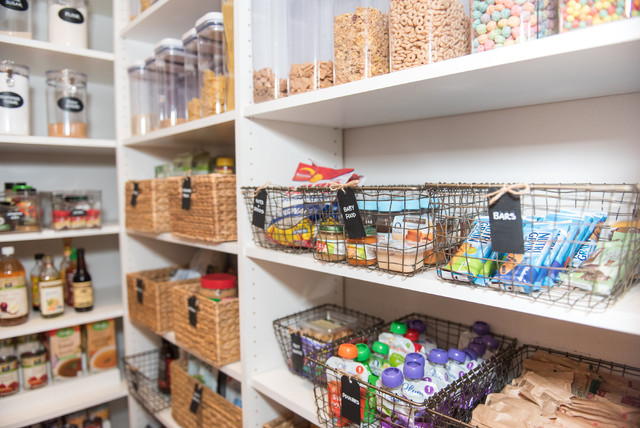5 Organizing Tasks to Tackle as Summer Winds Down
Readjust to In-Person Learning
If you have children who have been learning remotely and will resume full-time, in-person classes this fall, consider how to transition them smoothly and regain your space at home.
You may have purchased a lot of supplies and equipment — extra paper, pens, pencils, art supplies, glue, scissors and more — to manage home-schooling during the pandemic. These items that normally would stay in the classroom may now be taking up significant space in your multipurpose home.
Organize these items, starting with “shopping” from your stash and pulling out those necessary for the upcoming in-person school year.
If you have children who have been learning remotely and will resume full-time, in-person classes this fall, consider how to transition them smoothly and regain your space at home.
You may have purchased a lot of supplies and equipment — extra paper, pens, pencils, art supplies, glue, scissors and more — to manage home-schooling during the pandemic. These items that normally would stay in the classroom may now be taking up significant space in your multipurpose home.
Organize these items, starting with “shopping” from your stash and pulling out those necessary for the upcoming in-person school year.
It may be premature to get rid of all home-schooling supplies, since the coronavirus hasn’t been completely contained yet and guidelines could change. It may be wise to prepare for potential stay-at-home orders again if cases continue to surge. But you can still organize and pare down your items.
Depending on their condition, consider tossing, recycling or donating age- and grade-specific items, such as outgrown workbooks, crayons, finger paints, math games and flash cards. I recommend storing the remaining useful items in a container with a lid.
At this time, most schools appear to be planning for in-person learning this fall. If that continues, you can store this container of home-schooling supplies in a less prime location, such as in the garage or back of a closet. Don’t forget about it, though. Once remote learning is behind you or the items in the container are no longer relevant for your family, donate them to benefit someone else.
Depending on their condition, consider tossing, recycling or donating age- and grade-specific items, such as outgrown workbooks, crayons, finger paints, math games and flash cards. I recommend storing the remaining useful items in a container with a lid.
At this time, most schools appear to be planning for in-person learning this fall. If that continues, you can store this container of home-schooling supplies in a less prime location, such as in the garage or back of a closet. Don’t forget about it, though. Once remote learning is behind you or the items in the container are no longer relevant for your family, donate them to benefit someone else.
Prep for Morning Routines
With the return to the classroom or workplace comes the return of the chaotic morning routine. Consider what your daily exit flow will be and how you can situate items to make leaving the house and putting things away when you get home more efficient.
With the return to the classroom or workplace comes the return of the chaotic morning routine. Consider what your daily exit flow will be and how you can situate items to make leaving the house and putting things away when you get home more efficient.
Having a designated spot by the front or garage door for bags, backpacks, jackets, shoes and face masks can help prevent a scramble in the morning. Something as simple as a damage-free, removable hook for each family member’s mask should get the job done.
Optimize Your Remote-Work Setup
If you’ll continue to work from home this fall or even longer, consider setting up your home office with ergonomics in mind if you haven’t already. At the beginning of the pandemic, you may have created a makeshift workspace — and possibly even chosen your “office” location based on what would make the most attractive virtual conferencing background.
If these setups don’t support proper posture, the small stresses tolerated by your body in the short term can accumulate into potential injuries. It may be wise to invest in appropriate furniture and accessories to create an ergonomic work environment in your home office.
If you’ll continue to work from home this fall or even longer, consider setting up your home office with ergonomics in mind if you haven’t already. At the beginning of the pandemic, you may have created a makeshift workspace — and possibly even chosen your “office” location based on what would make the most attractive virtual conferencing background.
If these setups don’t support proper posture, the small stresses tolerated by your body in the short term can accumulate into potential injuries. It may be wise to invest in appropriate furniture and accessories to create an ergonomic work environment in your home office.
Be sure your chair is not only comfortable but supports a neutral posture and assists you in maintaining the natural curves of your spine. The armrests shouldn’t hinder you from relaxing your shoulders and keeping your elbows by your side. Consider purchasing a footrest so your body can maintain proper alignment if your feet don’t firmly touch the ground.
Risers may help you sit up straighter if you find yourself constantly hunched over to view your monitor. If you use a laptop, adding a separate keyboard so your keyboard and monitor can be positioned at different proper heights can also help with posture.
Most tables have a standard height of 29 inches. In my previous career as an ergonomics consultant, I found that placing keyboards at this height was too high for most people — I’ve recommended clients either raise their chairs (and then obtain a footrest if necessary) or install a keyboard tray underneath their desk so the keyboard can be placed at a height that allows for typing with a neutral wrist posture.
Risers may help you sit up straighter if you find yourself constantly hunched over to view your monitor. If you use a laptop, adding a separate keyboard so your keyboard and monitor can be positioned at different proper heights can also help with posture.
Most tables have a standard height of 29 inches. In my previous career as an ergonomics consultant, I found that placing keyboards at this height was too high for most people — I’ve recommended clients either raise their chairs (and then obtain a footrest if necessary) or install a keyboard tray underneath their desk so the keyboard can be placed at a height that allows for typing with a neutral wrist posture.
Share Excess Pandemic Food
Early in the pandemic, I stocked up on groceries, not because I was worried about the supply chain of food, but more because I wanted to maximize the time between shopping trips. I selected items with long shelf lives that would be able to sustain my family through the pandemic. These foods aren’t ones we necessarily enjoy on a regular basis, and I have bypassed them many times this past year.
It’s definitely time for me to share them with others who will appreciate them more. In the future I will commit to buying only foods my family actually likes to eat. Beware also of bulk purchases — they require bulk storage. If you haven’t gotten around to eating something you bought early in the pandemic, perhaps you don’t have any intention to. Donate nonexpired foods to local shelters and food banks.
Early in the pandemic, I stocked up on groceries, not because I was worried about the supply chain of food, but more because I wanted to maximize the time between shopping trips. I selected items with long shelf lives that would be able to sustain my family through the pandemic. These foods aren’t ones we necessarily enjoy on a regular basis, and I have bypassed them many times this past year.
It’s definitely time for me to share them with others who will appreciate them more. In the future I will commit to buying only foods my family actually likes to eat. Beware also of bulk purchases — they require bulk storage. If you haven’t gotten around to eating something you bought early in the pandemic, perhaps you don’t have any intention to. Donate nonexpired foods to local shelters and food banks.
Sort Personal Protective Equipment
After more than a year of wearing masks, you may have a better idea of which style is most comfortable for you. If you’ve accrued some that your family doesn’t use, consider giving away or eliminating those and saving just your preferred types.
I believe mask wearing will continue at least in the near term so be sure to save enough for your family’s needs. I use washable, reusable masks, so I keep enough to last between laundry days. I also have a supply of N95 masks to use when I’m in more crowded public spaces, and I’m anticipating using them again for working indoors with clients. Some prefer to use surgical masks.
After more than a year of wearing masks, you may have a better idea of which style is most comfortable for you. If you’ve accrued some that your family doesn’t use, consider giving away or eliminating those and saving just your preferred types.
I believe mask wearing will continue at least in the near term so be sure to save enough for your family’s needs. I use washable, reusable masks, so I keep enough to last between laundry days. I also have a supply of N95 masks to use when I’m in more crowded public spaces, and I’m anticipating using them again for working indoors with clients. Some prefer to use surgical masks.
With still so many unknowns about the virus and its variants, it seems prudent to remain cautiously optimistic as we reintroduce pre-pandemic activities.
I do believe that we are better prepared now and may not have to face the frenzy of stocking up on food and supplies, which will hopefully allow us to keep our homes and lives more organized.
I do believe that we are better prepared now and may not have to face the frenzy of stocking up on food and supplies, which will hopefully allow us to keep our homes and lives more organized.






Comments
Post a Comment